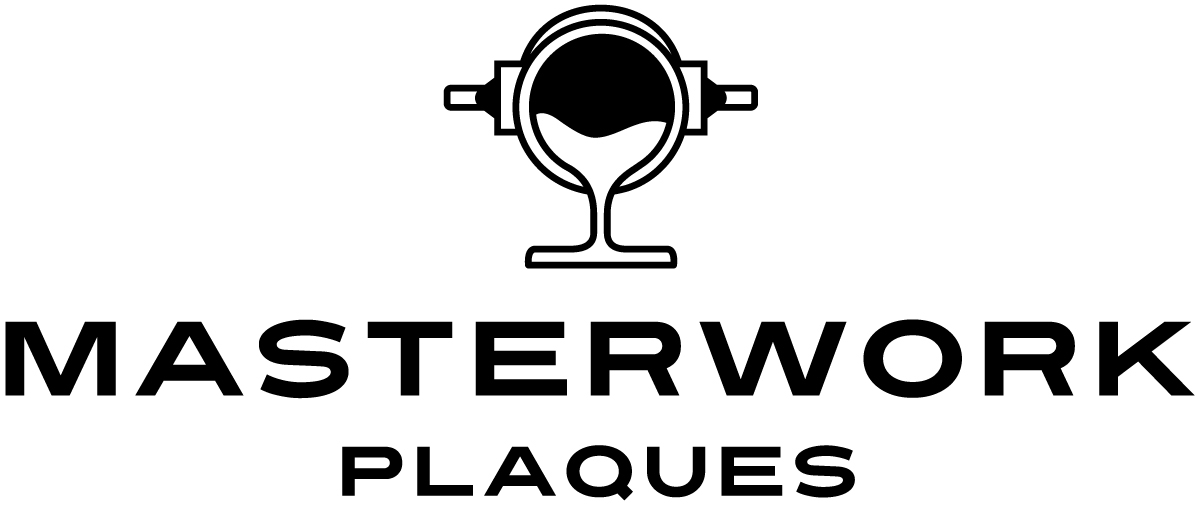We believe in providing knowledgeable and friendly customer service.
Frequently Asked Questions - Metal Types & Plaque Comparisons
METALS & COMPARISONS
What is the difference between a cast plaque and an etched plaque?
Cast plaques are created by pouring molten metal into a mold. Once the metal cools, it solidifies into a solid plaque. Cast plaques typically have raised lettering and graphics which protrude from the plaque by about 3/32", which is more substantial than raised areas on an etched plaque. You will find many cast bronze plaques installed outdoors as they are very durable and withstand most climates and all four seasons.
Etched plaques are created using a chemical engraving process that eats away at a sheet of metal to create a design or written text. The shallow, recessed letters and graphics are then typically filled with a black paint (or any other color) while the remaining areas stay the original color of the metal. The etching process allows for thinner line-work than is possible in the casting process, but the tradeoff is that the details are created in a shallow relief. On these plaques, all recessed areas are only etched about 0.01" into the metal.
What is the difference between paint and “chemical patina”?
Typically the backgrounds of our plaques are colored for contrast and aesthetic appeal . Colored backgrounds also increase text legibility, so that the plaque is easier to read from far away. Bronze plaques have the added ability to be colored using a chemical patina. What is important to note is that Masterwork Plaques’ true patina chemically changes the surface color of the bronze, so it will not peel away or chip off over time. This is especially important for plaques that are inset into the ground. Plaques that are finished with paint can have adverse chipping affects because the paint simply sits on top of the metal. A patina is a more expensive process than what most bronze artists and plaque makers are willing to use. Many of our competitors use other products with names like chem-col, polychrome patinas and graphite sprays which are really just paint. If the bronze work is set in a horizontal position, i.e. in the pavement, and rainwater collects on it, these paint products will start to peel in a few years.
Should I use cast bronze or cast aluminum for my plaque?
We create cast plaques using both bronze and aluminum alloys. Bronze is the higher quality metal option, so if you are planning to install your plaque outdoors or underfoot, we would highly recommend cast bronze. Bronze is also great for more traditional plaques, as it is the most common metal used for historic projects.
Cast aluminum plaques are cheaper to make and a good alternative to bronze for tight budget projects. Aluminum is a much softer metal, and it is significantly lighter in weight than cast bronze. The silver color also has a more contemporary look and feel. Aluminum plaques are not recommended for plaques that are inset into the ground or installed in high traffic areas.
What is the difference between aluminum and stainless steel?
Both stainless steel and aluminum are silver in color, yet they are quite different when it comes to their other characteristics, specifically regarding their density and weight. Similar to bronze, stainless steel is a dense, high quality metal. It is more expensive than aluminum because it has a corrosive-resistant surface and is less likely to dent or warp over time. It is also resistant to discoloration because of its non-porous surface.
As mentioned above, aluminum is a much softer metal, and it is significantly lighter in weight than stainless steel and bronze. Aluminum is a great alternative to stainless steel if you need to create a large plaque on a small budget. Aluminum is a softer metal and can bend if it is dropped or used in high traffic areas.
What is the difference between bas-relief and a photo-rendered portrait plaque?
The most traditional portrait type is created using a “bas-relief” technique. Using this method, one of our professional artists will hand carve a sculpted portrait of the subject based on the photograph of your choice. Originally carved in clay, then molded and cast in bronze or aluminum, this technique largely relies on the skills of our clay artists. This portrait technique takes 8-10 weeks to complete.
Alternatively, the photo-rendered technique digitally translates a photograph into metal. It retains many of the details of the photograph, ensuring a high quality, exact reproduction in bronze. This is a less time consuming technique than the hand-carved portrait option, with manufacturing time running around 4 weeks.
